Control of EMI in High-Technology Nano Fab by Exploitation Power Transmission Method with Ideal Permutation
Abstract
:1. Introduction
2. Theoretical Study and Simulation Models
3. Results and Discussion
3.1. Experimental Results
3.2. Simulated Results
3.3. Discussion
4. Conclusions
Author Contributions
Funding
Institutional Review Board Statement
Informed Consent Statement
Data Availability Statement
Conflicts of Interest
References
- Thornley, R.M.F.; Hutchinson, J.D. Magnetic field measurement in the scanning electron microscope. Appl. Phys. Lett. 1968, 13, 249–250. [Google Scholar] [CrossRef]
- Yield Enhancement, International Technology Roadmap for Semiconductor (ITRS), 2007 Edition. Available online: https://link.springer.com/chapter/10.1007%2F978-3-642-23096-7_7 (accessed on 10 June 2021).
- Zhou, W.; Wang, Z.L. (Eds.) Scanning Microscopy for Nanotechnology: Techniques and Applications; Springer Science & Business Media: Berlin/Heidelberg, Germany, 2007; pp. 1–41. [Google Scholar]
- Wardly, G.A. Magnetic contrast in the scanning electron microscope. J. Appl. Phys. 1971, 42, 376–386. [Google Scholar] [CrossRef]
- Integration, International Technology Roadmap for Semiconductor (ITRS) 2009 Edition, Factory. 2009, pp. 1–33. Available online: https://www.semiconductors.org/resources/2009-international-technology-roadmap-for-semiconductors-itrs/ (accessed on 10 June 2021).
- Yamazaki, K.; Hirosato, S.; Muramatu, K.; Hirayama, M.; Kamata, K.; Onoki, T.; Kobayashi, K.; Haga, A.; Katada, K.; Kinomura, Y.; et al. Open-Type Magnetically Shielded Room Using Only Canceling Coil without a Ferromagnetic Wall for Magnetic Resonance Imaging. IEEE Trans. Magn. 2007, 43, 2480–2482. [Google Scholar] [CrossRef]
- Saito, T. Features of a Wall with Open-Type Magnetic Shielding Method. IEEE Trans. Magn. 2008, 44, 4191–4194. [Google Scholar] [CrossRef]
- Moreno, P.; Olsen, R.G. A Method for Estimating Magnetic Shielding by 2-D-Thick Planar Plates for Distribution Systems Shielding. IEEE Trans. Power Deliv. 2010, 25, 2710–2716. [Google Scholar] [CrossRef]
- Song, Y.-L.; Yu, C.; Chuang, F.-C.; Tseng, Y.-C.; Zou, J.-Y.; Hsu, S.-K.; Ma, T.-G.; Wu, T.-L.; Chang, L.-M. Evaluation of magnetic field from varied permutation power transmission line at high technology nanofiber. In Proceedings of the 2011 4th International Conference on Power Electronics Systems and Applications, Hong Kong, China, 8–10 June 2011. [Google Scholar]
- Chuang, F.-C.; Song, Y.-L.; Yu, C.; Shsu, S.-G.; Ma, T.-G.; Wu, T.-L.; Chang, L.-M.; Yang, C.-Y. Active field canceling system in next generation nano-Fab. J. Energy Power Eng. 2012, 6, 1163–1169. [Google Scholar]
- SEMI E33-94. Pecification for Semiconductor Manufacturing Facility Electromagnetic Compatibility; Semiconductor Equipment and Materials International: Mountanin View, CA, USA, 1992. [Google Scholar]
- Basyigit, I.B.; Caglar, M.F. Investigation of the magnetic shielding parameters of rectangular enclosures with apertures at 0 to 3 GHz. Electromagnetics 2016, 36, 434–446. [Google Scholar] [CrossRef]
- Cardelli, E.; Faba, A.; Pirani, A. Nonferromagnetic open shields at industrial frequency rate. IEEE Trans. Magn. 2009, 46, 889–898. [Google Scholar] [CrossRef]
- Xia, N.; Du, Y. An efficient modeling method for 3-D magnetic plates in magnetic shielding. IEEE Trans. Electromagn. Compat. 2013, 56, 608–614. [Google Scholar] [CrossRef]
- Sun, W.L.; Chuang, F.C.; Song, Y.L.; Yu, C.; Ma, T.G.; Wu, T.L.; Chang, L.M. Active magnetic field canceling system. In Proceedings of the 2013 9th International Workshop on Electromagnetic Compatibility of Integrated Circuits (EMC Compo), Nara, Japan, 15–18 December 2013; pp. 119–122. [Google Scholar]
- Shih, F.Y.; Chen, D.Y.; Wu, Y.P.; Chen, Y.T. Procedure for Designing EMI Filters for AC Line Applications. IEEE Trans. Power Electron. 1996, 11, 170–181. [Google Scholar] [CrossRef]
- Zhang, W. Integrated EMI/Thermal design for Switching Power Supplies. Ph.D. Dissertation, Virginia Tech, Blacksburg, VA, USA, 1998. [Google Scholar]
- Hwang, J.-H.; Kang, T.-W.; Kwon, J.-H.; Park, S.-O. Effect of Electromagnetic Interference on Human Body Communication. IEEE Trans. Electromagn. Compat. 2016, 59, 48–57. [Google Scholar] [CrossRef]
- EMF Safety Standards by EMF Wise. Available online: http://www.emfwise.com/emf-safety-standards.php (accessed on 10 June 2021).
- The Existing Public Exposure Standards Cindy Sage, MA Sage Associates, USA on Bioinitiatie. 2012. Available online: https://bioinitiative.org/wp-content/uploads/pdfs/sec03_2007_Existing_Public_Exposure_Standards.pdf (accessed on 10 June 2021).
- Hikage, T.; Nojima, T.; Simba, A.Y.; Watanabe, S. Numerical estimation of EMI impact on implantable cardiac pacemakers in elevator using EMF distributions inside human body. In Proceedings of the 2010 IEEE Antennas and Propagation Society International Symposium, Toronto, ON, Canada, 11–17 July 2010; pp. 1–4. [Google Scholar] [CrossRef] [Green Version]
- Lin, J. A new IEEE standard for safety levels with respect to human exposure to radio-frequency radiation. IEEE Antennas Propag. Mag. 2006, 48, 157–159. [Google Scholar] [CrossRef] [Green Version]
- International Agency for Research on Cancer. Non-ionizing radiation, part 1: Static and extremely low-frequency (ELF) electric and magnetic fields. IARC Monogr. Eval. Carcinog. Risks Hum. 2002, 80, 1–395. [Google Scholar]
- Mattsson, M.O.; Simkó, M. Grouping of experimental conditions as an approach to evaluate effects of extremely low-frequency magnetic fields on oxidative response in in vitro studies. Front. Public Health 2014, 2, 132. [Google Scholar] [CrossRef] [PubMed] [Green Version]
- Markov, M.S. Dosimetry of magnetic fields in the radiofrequency range. In Radio Frequency Radiation Dosimetry and Its Relationship to the Biological Effects of Electromagnetic Fields; Klauenberg, B.J., Miklavčič, D., Eds.; Kluwer Academic Press: New York, NY, USA, 2000; pp. 239–245. [Google Scholar]
- Ilonen, K.; Markkanen, A.; Mezei, G.; Juutilainen, J. Indoor transformer stations as predictors of residential ELF magnetic field exposure. Bioelectromagnetics 2007, 29, 213–218. [Google Scholar] [CrossRef]
- Vulević, B.; Osmokrović, P. Survey of ELF magnetic field levels in households near overhead power lines in Serbia. Radiat. Prot. Dosim. 2011, 145, 385–388. [Google Scholar] [CrossRef] [PubMed]
- Lewczuk, B.; Redlarski, G.; Żak, A.; Ziółkowska, N.; Przybylska-Gornowicz, B.; Krawczuk, M. Influence of electric, magnetic, and electromagnetic fields on the circadian system: Current stage of knowledge. BioMed Res. Int. 2014, 2014, 169459. [Google Scholar] [CrossRef] [Green Version]
- McCann, J.; Dietrich, F.; Rafferty, C. The genotoxic potential of electric and magnetic fields: An update. Mutat. Res. Mutat. Res. 1998, 411, 45–86. [Google Scholar] [CrossRef]
- Poulletier de Gannes, F.; Lagroye, I.; Veyret, B. D3—Report on the Analysis of Risks Associated to Exposure to EMF: In Vitro and In Vivo (Animals) Studies. European Health Risk Assessment Network on Electromagnetic Fields Exposure (EFHRAN). 2010. Available online: http://eThran.polimi.it/docs/IMS-EFHRAN_09072010.pdf (accessed on 10 June 2021).
- Turner, M.C.; Benke, G.; Bowman, J.D.; Figuerola, J.; Fleming, S.; Hours, M.; Kincl, L.; Krewski, D.; McLean, D.; Parent, M.-E.; et al. Occupational Exposure to Extremely Low-Frequency Magnetic Fields and Brain Tumor Risks in the INTEROCC Study. Cancer Epidemiol. Biomark. Prev. 2014, 23, 1863–1872. [Google Scholar] [CrossRef] [Green Version]
- Soffritti, M.; Tibaldi, E.; Padovani, M.; Hoel, D.G.; Giuliani, L.; Bua, L.; Lauriola, M.; Falcioni, L.; Manservigi, M.; Manservisi, F.; et al. Synergism between sinusoidal-50 Hz magnetic field and formaldehyde in triggering carcinogenic effects in male Sprague-Dawley rats. Am. J. Ind. Med. 2016, 59, 509–521. [Google Scholar] [CrossRef]
- International Agency for Research on Cancer. IARRC Classifies Radiofrequency Electromagnetic Fields as Possibly Carcinogenic to Humans; Press Release No 2008; International Agency for Research on Cancer: Lyon, France, 2011. [Google Scholar]
- Dondoladze, K.; Nikolaishvili, M.; Museliani, T.; Jikia, G.; Zurabashvili, D. The Impact of Electromagnetic Field on Conditioned Reflex Memory. NeuroQuantology 2018, 16, 93–100. [Google Scholar] [CrossRef]
- Hertz, E. Thermal and EMI Modeling and Analysis of a Boost PFC Circuit Designed Using a Genetic-based Optimization Algorithm. Ph.D. Dissertation, Virginia Polytechnic Institute and State University, Blacksburg, VA, USA, 2001. Available online: http://hdl.handle.net/10919/34234 (accessed on 12 June 2021).
- Qu, S. Non-Intrinsic Differential Mode Noise in Switching Power Supplies and Its Implications to EMI Filter Design. Master’s Thesis, Virginia Polytechnic Institute and State University, Blacksburg, VA, USA, 2014. Available online: http://hdl.handle.net/10919/9788 (accessed on 19 June 2021).
- Zhang, M.T. Electrical, Thermal, and EMI Designs of High-Density, Low-Profile Power Supplies. Ph.D. Dissertation, Virginia Polytechnic Institute and State University, Blacksburg, VA, USA, 1997. Available online: http://hdl.handle.net/10919/30316 (accessed on 10 June 2021).
- Rao, K.R. Wind Energy for Power Generation: Meeting the Challenge of Practical Implementation; Springer: Berlin/Heidelberg, Germany, 2019. [Google Scholar]
- Harlow, J.H. Electric Power Transformer Engineering; CRC Press: Boca Raton, FL, USA, 2007. [Google Scholar]
- Fritsch, A.; Uhlig, R.; Marocco, L.; Frantz, C.; Flesch, R.; Hoffschmidt, B. A comparison between transient CFD and FEM simulations of solar central receiver tubes using molten salt and liquid metals. Sol. Energy 2017, 155, 259–266. [Google Scholar] [CrossRef]
- Dratt, M.; Katterfeld, A. Coupling of FEM and DEM simulations to consider dynamic deformations under particle load. Granul. Matter 2017, 19, 1–15. [Google Scholar] [CrossRef]
- Piltyay, S.; Bulashenko, A.; Herhil, Y.; Bulashenko, O. FDTD and FEM simulation of microwave waveguide polarizers. In Proceedings of the 2020 IEEE 2nd International Conference on Advanced Trends in Information Theory (ATIT), Kyiv, Ukraine, 25–27 November 2020; pp. 357–363. [Google Scholar]
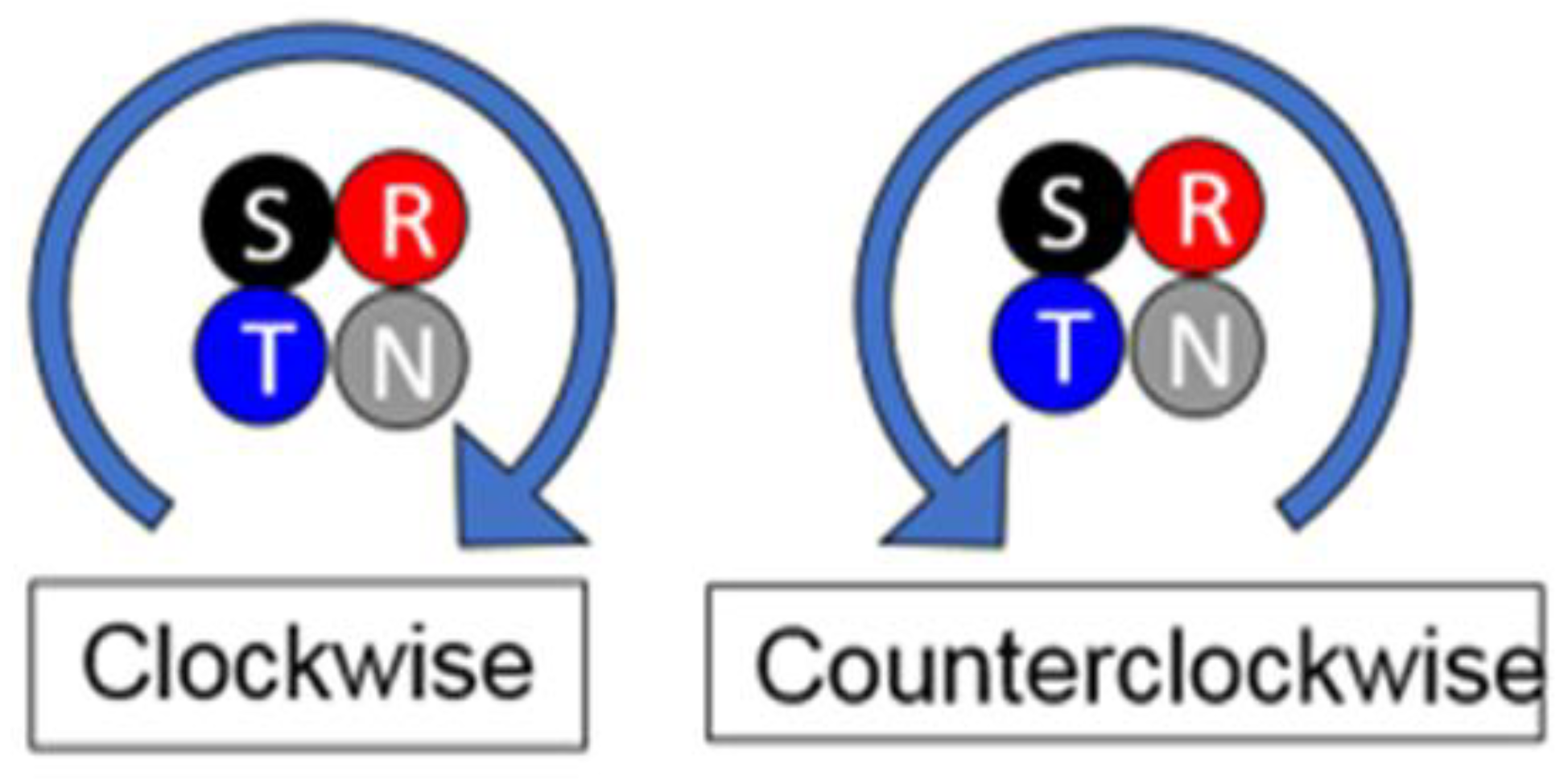
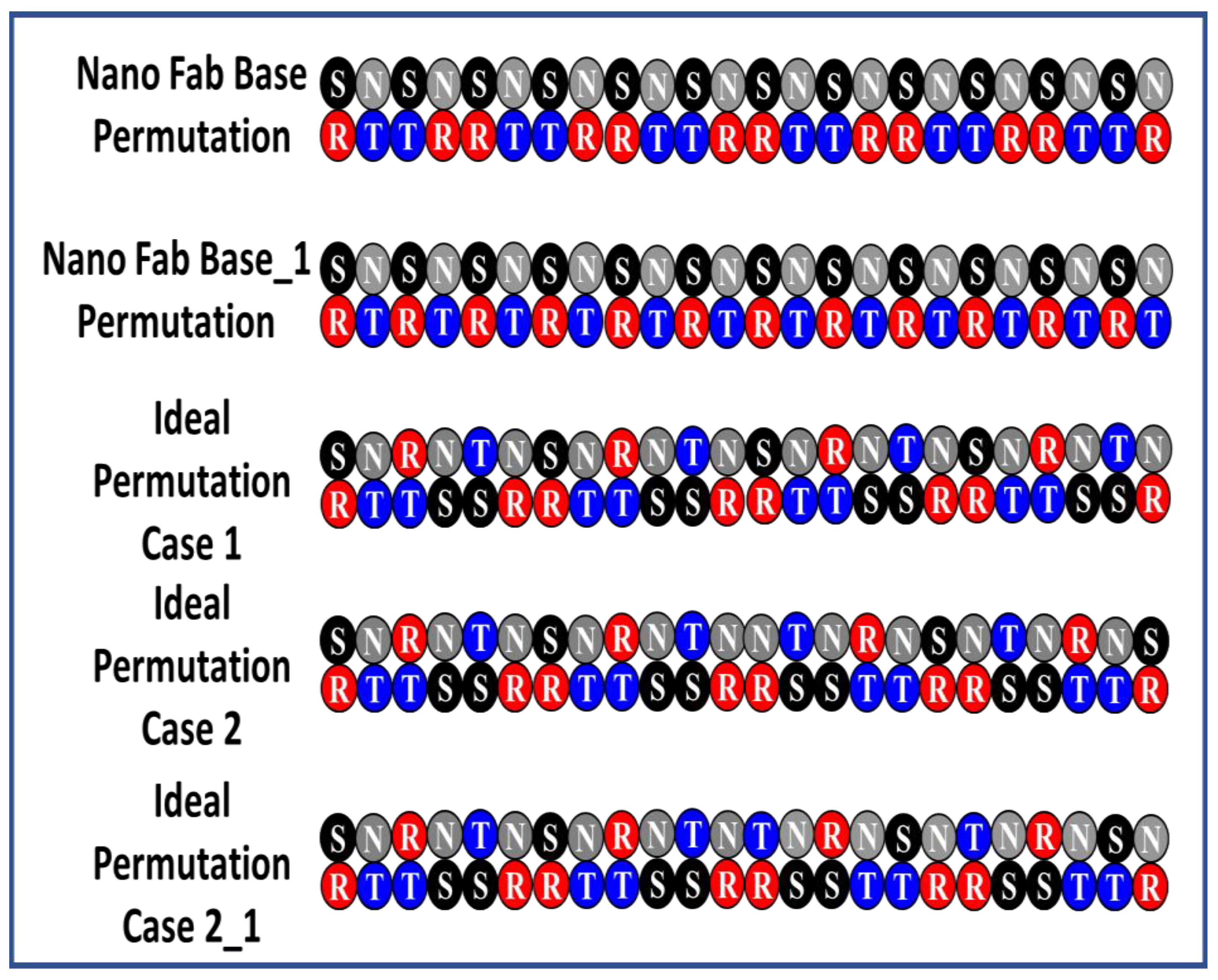


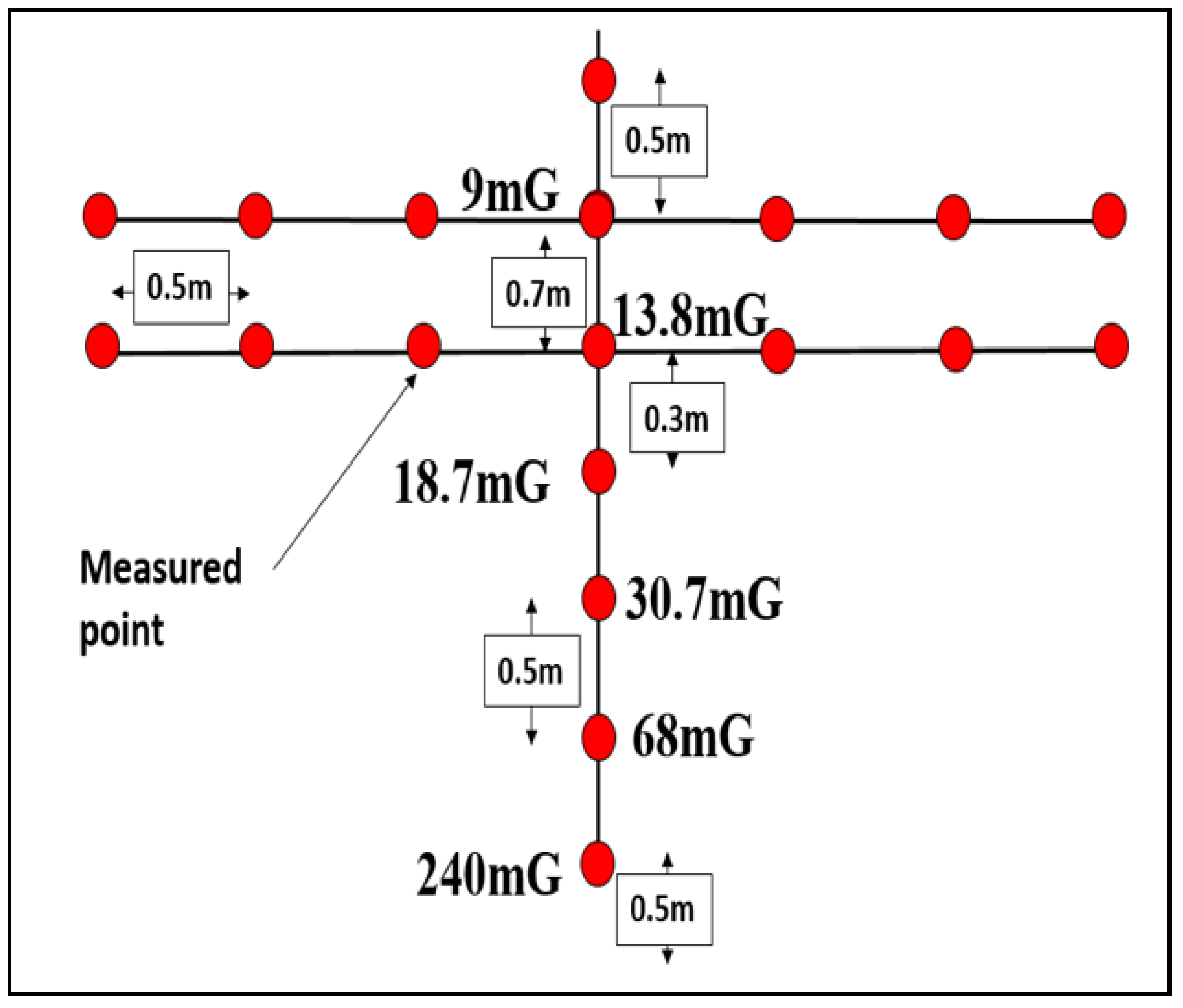

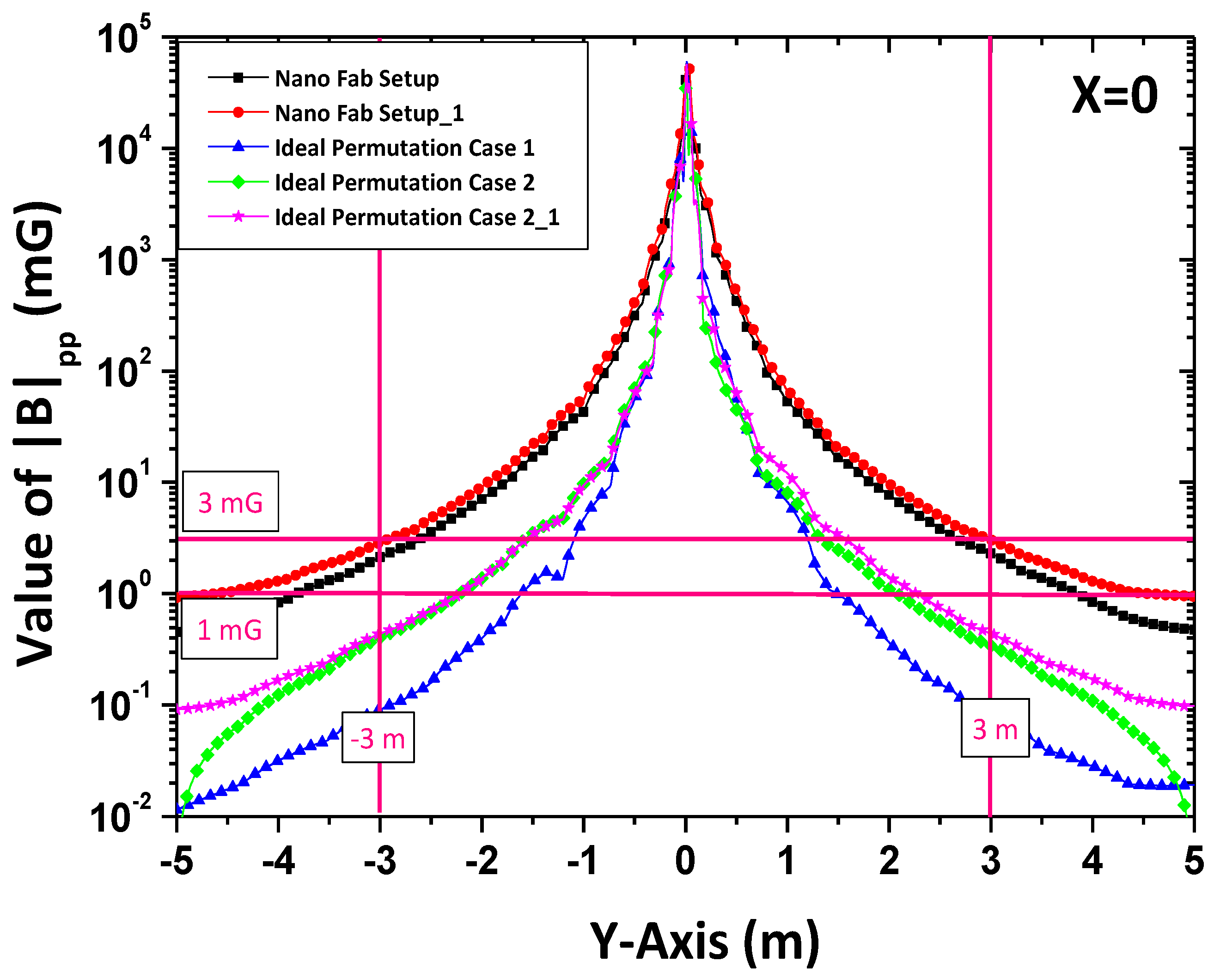
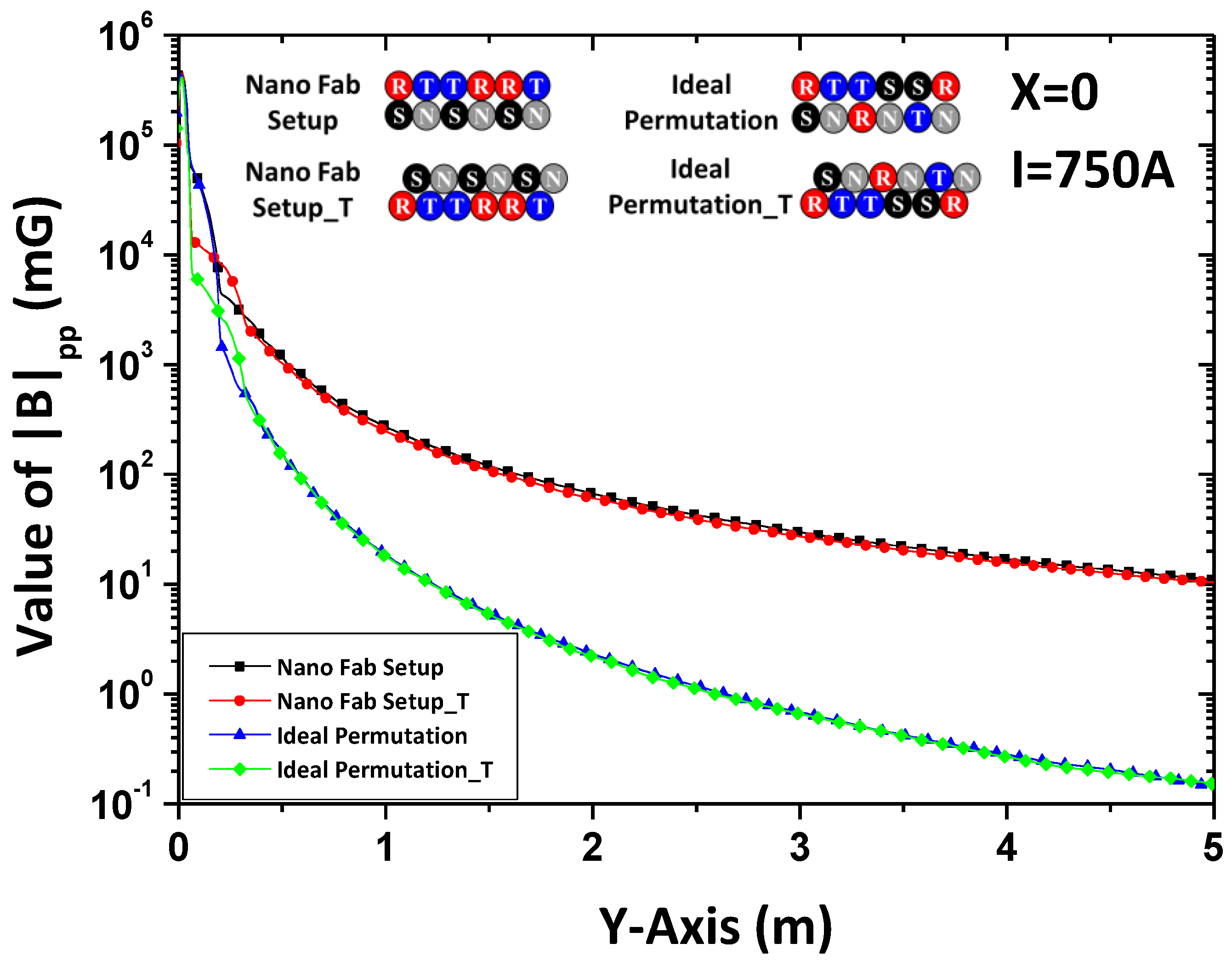

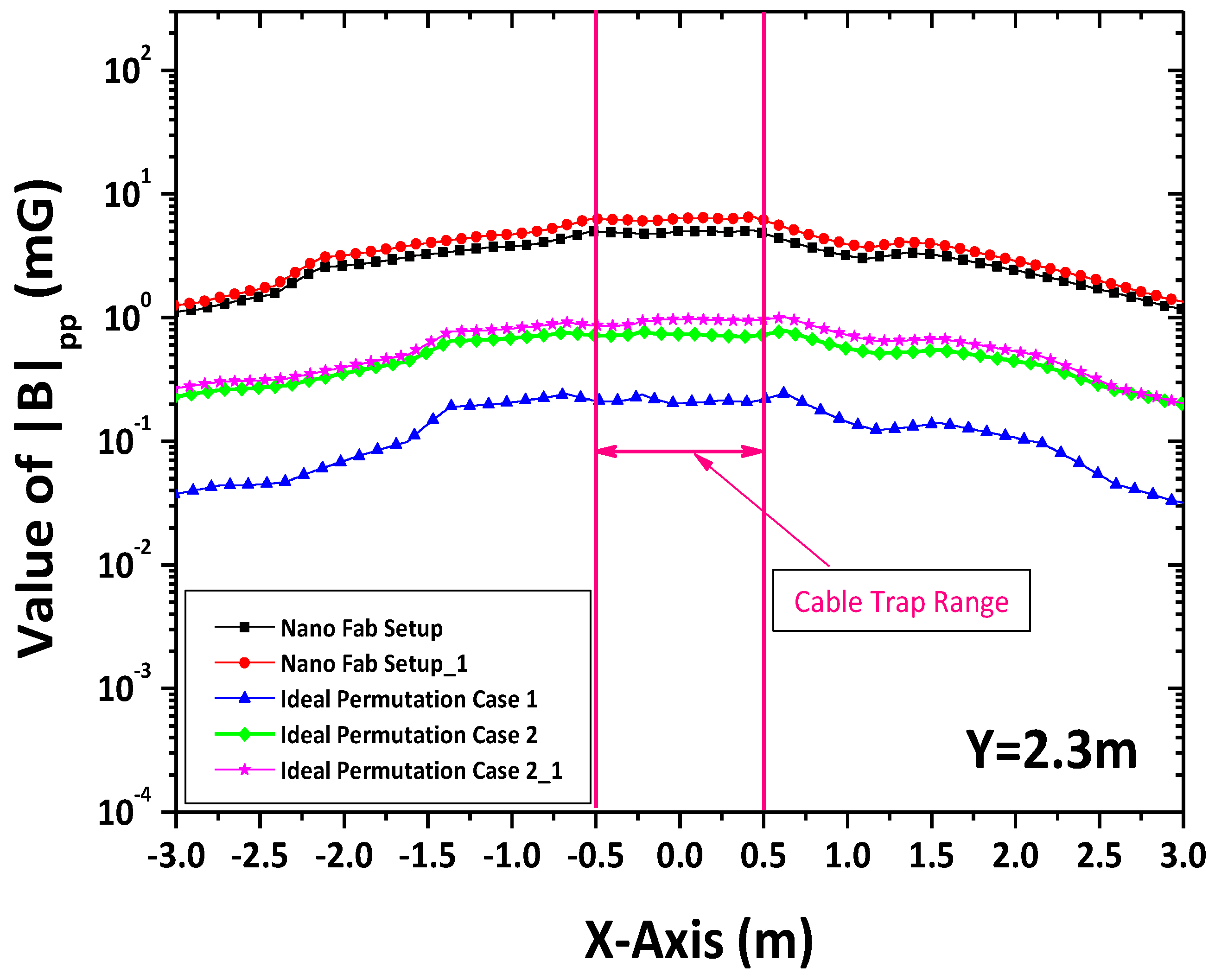

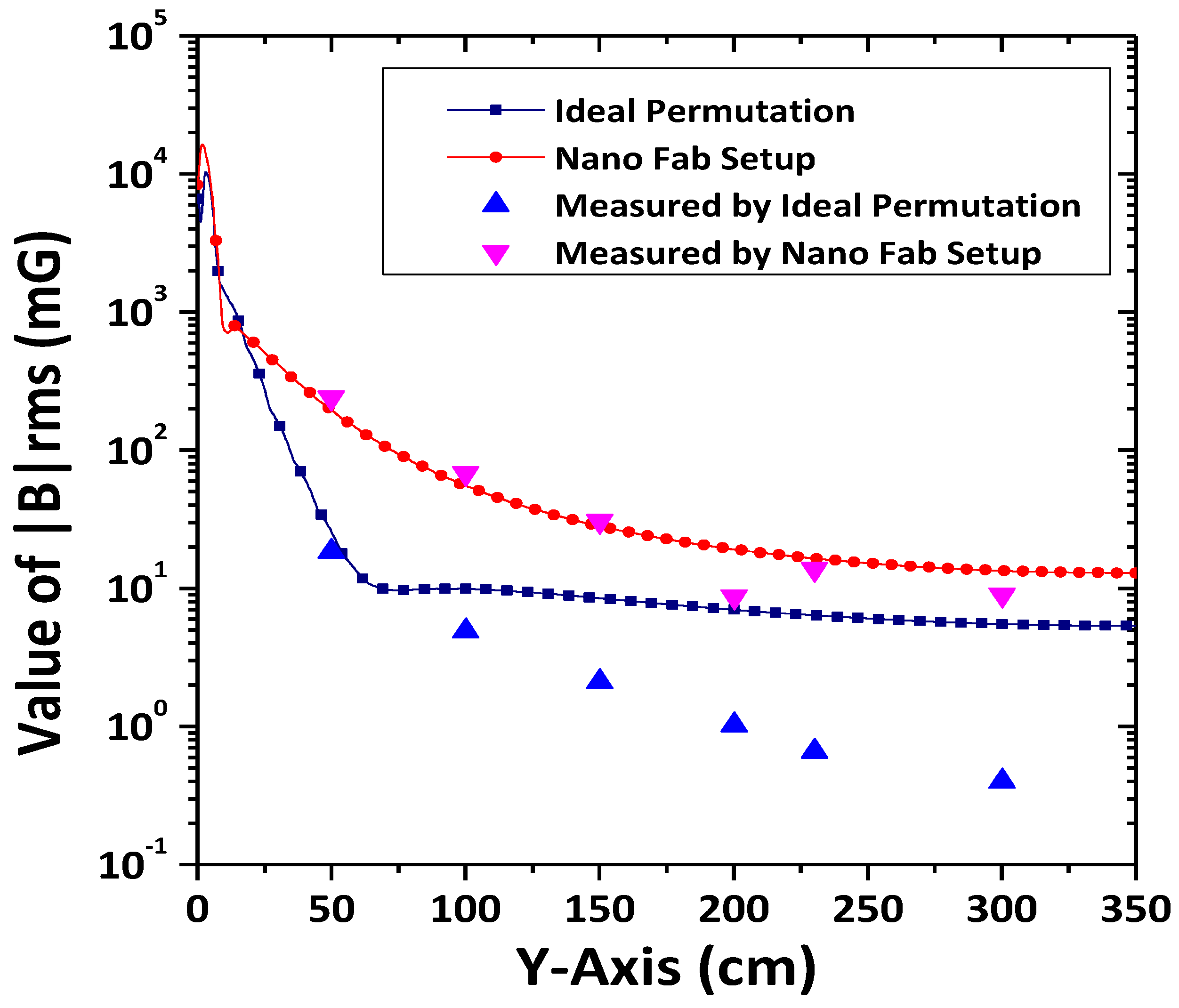


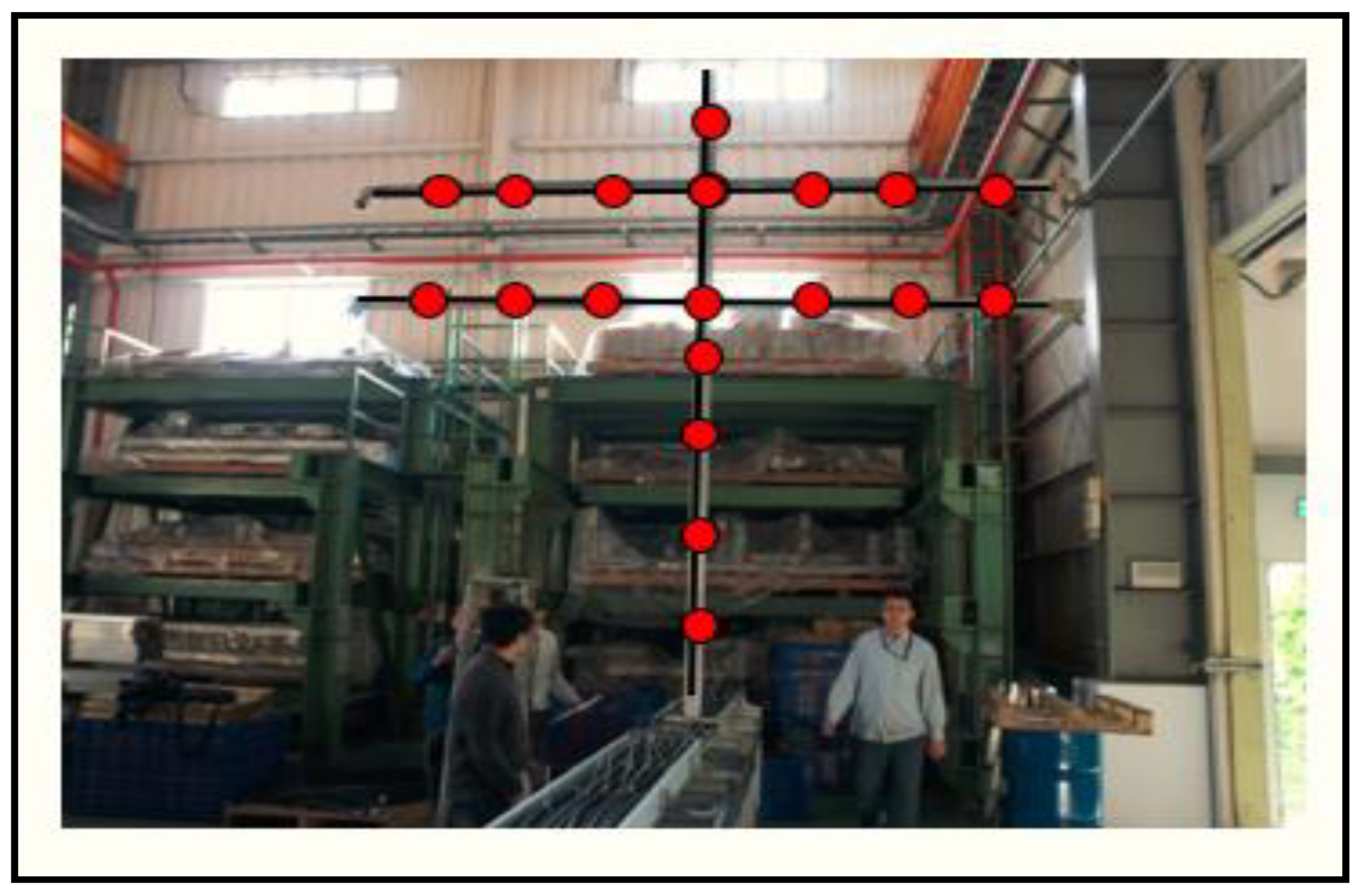
Publisher’s Note: MDPI stays neutral with regard to jurisdictional claims in published maps and institutional affiliations. |
© 2021 by the authors. Licensee MDPI, Basel, Switzerland. This article is an open access article distributed under the terms and conditions of the Creative Commons Attribution (CC BY) license (https://creativecommons.org/licenses/by/4.0/).
Share and Cite
Song, Y.-L.; Reddy, M.K.; Lin, H.-Y.; Chang, L.-M. Control of EMI in High-Technology Nano Fab by Exploitation Power Transmission Method with Ideal Permutation. Appl. Sci. 2021, 11, 11984. https://doi.org/10.3390/app112411984
Song Y-L, Reddy MK, Lin H-Y, Chang L-M. Control of EMI in High-Technology Nano Fab by Exploitation Power Transmission Method with Ideal Permutation. Applied Sciences. 2021; 11(24):11984. https://doi.org/10.3390/app112411984
Chicago/Turabian StyleSong, Yu-Lin, Manoj Kumar Reddy, Hung-Yi Lin, and Luh-Maan Chang. 2021. "Control of EMI in High-Technology Nano Fab by Exploitation Power Transmission Method with Ideal Permutation" Applied Sciences 11, no. 24: 11984. https://doi.org/10.3390/app112411984
APA StyleSong, Y.-L., Reddy, M. K., Lin, H.-Y., & Chang, L.-M. (2021). Control of EMI in High-Technology Nano Fab by Exploitation Power Transmission Method with Ideal Permutation. Applied Sciences, 11(24), 11984. https://doi.org/10.3390/app112411984





